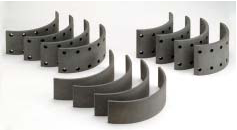Friction Materials: Essential for Motion Control & Braking
Let’s imagine for a moment a world without friction, which is, simply put, the force resistant to movement when any two objects rub against each other. Wait a second… that’s just too chaotic! If you think the world is a disaster now, just take away friction and… boom! Everything crashes into everything because there’s no force to stop it. So, here’s what I’ll do: I’ll just take away the friction between your posterior and what it’s sitting on… I need a good laugh today. You can’t stay put can you? Keep slipping and sliding, huh?
Friction has been jokingly referred to as the “evil” of all motion because it always pulls in the opposite direction of where something is moving. So, how do we get anywhere? Well, friction is actually the essential motion controller – the force that puts on the brakes, so to speak. In this wintery Michigan weather, I could use some more friction between my shoes and the slick pavement, but, if fortunate, cautious driving, good brakes, and the city putting down salt or sand to increase friction will keep drivers safe. The friction materials present in our cars are probably the most familiar.
Taking a look at friction on a small scale, most objects in our everyday life can generate friction even though they may seem to have smooth surfaces. Microscopically, we would see that there are rough, jagged edges that grind and drag against each other, thus creating friction. I just stopped typing this article to examine my computer mouse and mouse pad… no, not random. Even though the mouse feels smooth in my hand, upon closer examination I see the mini-texturization that works together with the pad to create friction for fluid cursor-clicking.
Depending on how soon you put on the brakes in your car, its brake materials help create a fluid stop. I’m sure we’ve all experienced those jerky, maybe even heart-racing, stops. Whichever the case, brake systems engage materials like brake bands, brake lining & pads to rub against the brake disc or drum and slow down the vehicle by stopping the wheels from rotating. Additional friction is created from the tires rubbing against the road. Clutch discs and clutch facings are essential friction materials for reducing clutch clatter by offering smooth and consistent clutch engagement and disengagement. Without clutch materials, the clutch would slip and not transfer power for switching gears. Besides automobile, some other applications include draglines, dredges, tugs, cranes, ships and winches.

Thermofiber drum lining photos by ProTec Friction Supply
Friction materials must be capable of enduring the high temperatures created by the friction forces of braking, thus they must have good energy absorption properties. For years, asbestos fibers were the most popular type of friction material. When these were banned, manufacturers started to discover better substances, of which ceramic materials are a great example. Because of the variety of organic and synthetic friction materials, with new developments always popping up, varying coefficients of friction are available. It is important to understand the requirements of the task, like if quick stopping is an issue or if a lot of heat will be produced. Manufacturers will know what specific ingredients will work best.


 Castings & Forgings
Castings & Forgings Bulk Material Handling
Bulk Material Handling Electrical & Electronic Components
Electrical & Electronic Components Flow Instrumentation
Flow Instrumentation Hardware
Hardware Material Handling Equipment
Material Handling Equipment Metal Cutting Services
Metal Cutting Services Metal Forming Services
Metal Forming Services Metal Suppliers
Metal Suppliers Motion Control Products
Motion Control Products Plant & Facility Equipment
Plant & Facility Equipment Plant & Facility Supplies
Plant & Facility Supplies Plastic Molding Processes
Plastic Molding Processes Pumps & Valves
Pumps & Valves Recycling Equipment
Recycling Equipment Rubber Products & Services
Rubber Products & Services